Anniversary of Tönpa Shenrab Miwo’s Birth – a brief introduction to The Twelve Deeds
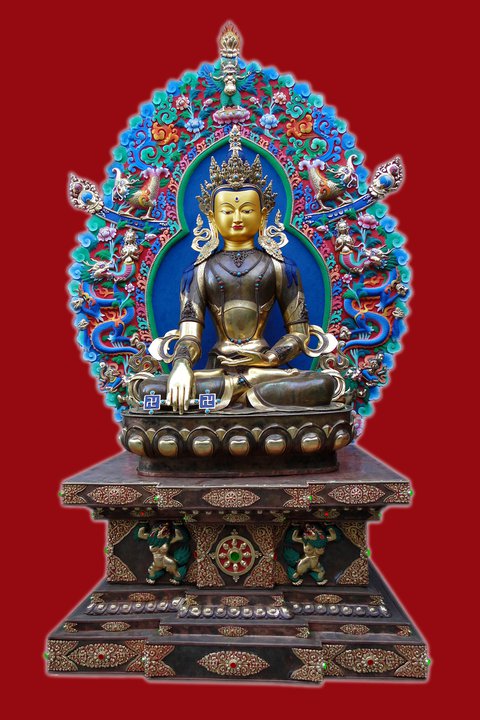
On the fifteenth day of the twelfth Tibetan month, we celebrate the anniversary of the First Deed of Yungdrung Bön’s Buddha Tönpa Shenrab Miwoche (Tib. Ston pa Gshen rab Mi bo che) – the Deed of Birth (Tib. Sku bltams-pa’i mdzad-pa).
Tönpa Shenrab – whose original name was Mura Tahen (Tib. Dmu-ra ta-han) – was born on the fifteenth day of the first month of Spring (Tib. me-stag-gi zla-ba) in the country of Olmo Lungring (Tib. ‘Ol-mo lung-ring), the central region of the larger country of Tagzig (Tib. Rtag-gzigs/Stag-gzig). It was in the Wood Male Mouse Year i.e. in 16,017 BC according to traditional Bönpo Chronology (Tib. Bstan-rtsis).
One may rightly ask: Why do we celebrate this anniversary in the twelfth month when it is said that Buddha was born in the first lunar month? The answer is: It is because this date is according to the ancient Zhang Zhung and Old Tibetan calendar which comes one month earlier than the current official Tibetan calendar calculated according to Hortsi or Horda – the Mongolian system (Tib. hor-rtsis / hor-zla) – that was introduced to Tibet in the thirteenth century by Chögyal Phagpa (Tib. Chos-rgyal ‘phags-pa), the Sakyapa (Tib. Sa-skya-pa) hierarch and tutor of the Mongol ruler of China Khubilai Khaan. The new calendar was mainly introduced as a political move to align the Tibetan and Chinese calendars so that the New Year would start on the same day of the same lunar month.[1]
Dates for Tönpa Shenrab’s life are calculated on the basis of the traditional interpretation of one shen-year (Tib. gshen-lo) being equal to one hundred human years. As it is said that Tönpa Shenrab Miwo lived 82 shen-years, his whole lifespan according to this reckoning is 8,200 years. But there are several other views on the date of Tönpa Shenrab’s birth, and his lifespan:
- For example, another dating for Tönpa Shenrab Miwo’s life was suggested by Chögyal Namkhai Norbu in his book Drung, Deu and Bön.[2] He traces the date for Tönpa Shenrab’s birth to 1917 BC and so, according to this dating and using a lifespan of 82 human years, Tönpa Shenrab’s parinirvana (Tib. mya-ngan las-‘das-pa) should have occurred in 1835 BC. This dating, however, is not accepted by Bönpo scholars I consulted;[3] they consider it to be too late.
- Khenpo Tenpa Yungdrung suggested another method of determining dates for Tönpa Shenrab. He maintains that the date of Tönpa Shenrab’s parinirvana (7817 BC) is certain and that it is this date which should be used as a historical reference. Furthermore, he does not rule out calculating this Buddha’s lifespan as 82 human years rather than 82 shen-years.[4] So according to this calculation, we add 82 to 7817 which gives us 7899 BC as the year of Tönpa Shenrab’s birth.
During his life, Shenrab Miwo manifested The Twelve Deeds of Buddha (Tib. Mdzad-chen bcu-gnyis). Here is a brief summary of this traditional account:
1. The Deed of Birth (Tib. Sku bltams-pa’i mdzad-pa)
Tönpa Shenrab, as he is known in our world, is the eighth Buddha of Yungdrung Bön. He became a fully realised Buddha in the Buddha Realm of Sipa Yesang (Tib. Srid-pa ye-sangs) before appearing on this Earth, where he was known as Salwa (Tib. Gsal-ba), Clarity, and also manifested as Chime Tsugphü (Tib. ‘Chi-med gtsug-phud), who figures in Buddha lineages of Bönpo Tantra and Dzogchen and who taught various sages, including Tagla Mebar (Tib. Stag-la me-’bar). Tönpa Shenrab was the middle brother of the three brothers who attained Buddhahood in that realm. The others were: the older brother Dagpa (Tib. Dag pa), Purity, and the younger brother Shepa (Tib. Shes pa), Knowledge. The older brother, Dagpa, incarnated on this Earth as a previous Buddha of Yungdrung Bön – Tönpa Togyal Yekhyen (Tib. Ston-pa Gto-rgyal ye-mkhyen). After his cycle of Yungdrung Bön teachings had run its course, the middle brother, Tönpa Shenrab, chose to be born in this world into the royal clan of Murigthrul (Tib. Dmu-rigs ‘phrul) in the Southern Palace of Barpo Sogye (Tib. Bar-po so-brgyad) at dawn on the fifteenth day of the first lunar month (according to the Zhang Zhung astrological system) in the Wood Male Mouse Year, when the Gyal (Tib. rgyal – ‘king’ or ‘victor’) constellation was in the sky. Tönpa Shenrab’s parents were King Mibön Hlabön Gyalbön Thodkar (Tib. Mi-bon lha-bon rgyal-bon thod-dkar) and Queen Machyi Hlachyi Yochyi Gyalzhema (Tib. Ma-phyi lha-phyi yo-phyi rgyal-bzhad-ma).
Tönpa Shenrab played joyfully for a year after his birth and then was enthroned as Murigthrul King.
2. The Deed of Propagation (Tib. Rnam-par spel-ba’i mdzad-pa)
Then for twelve years, the Buddha taught the Nine Ways of Bön (Tib. theg-pa rim-dgu’i bon):
The Bön of Cause (Tib. rgyu’i-bon):
1. Chyashen Thegpa (Tib. Phywa-gshen theg-pa)
2. Nagshen Thegpa (Tib. Snang-gshen theg-pa)
3. Thrulshen Thegpa (Tib. ‘Phrul-gshen theg-pa)
4. Sishen Thegpa (Tib. Srid-gshen theg-pa)
and The Bön of Fruit (Tib. ‘bras-bu’i bon):
5. Genyen Thegpa (Tib. Dge-bsnyen theg-pa)
6. Drangsong Thegpa (Tib. Drang-srong theg-pa)
7. Akar Thegpa (Tib. A-dkar theg-pa)
8. Yeshen Thegpa (Tib. Ye-gshen theg-pa)
9. Lame Thegpa/Dzogchen(Tib. Bla-med theg-pa/Rdzogs-chen).
He also taught The Bön of the Four Doors and the Fifth, the Treasury (Tib. Sgo-bzhi mdzod-lnga) as well as the Tantra of the Powerful Wheel of Time (Tib. dBang ldan dus kyi ‘khorlo’i rgyud), which he taught to the Lords of the Earth, the sabdag (Tib. sa bdag).
3. The Deed of Taming (Tib. Rnam-par dul-ba’i mdzad-pa)
In order to tame the beings of the Three Worlds (Tib. Khams-gsum), the Three Existences (Tib. Srid-gsum) and the Six Realms (Tib. ‘gro-ba rigs-drug), Tönpa Shenrab sent forth countless emanations from all parts of his body, such as Dulshen, Yeshen, Yendul, Shenpo (Tib. ‘dul-gshen, ye-gshen, g.yen-‘dul) etc. These emanations reached millions of worlds where they tame beings and lead them out of samsara.
4. The Deed of Leading (Tib. Rnam-pa ‘dren-pa’i mdzad-pa)
In order to free sentient beings from the afflictions of attachment and ignorance as well as envy, pride and desire, collectively known as the Five Poisons (Tib. dug-lnga), Tönpa Shenrab led all evil beings under the sway of great non-virtue to the Buddhahood of the Three Bodies (Tib. Sku-gsum sangs-rgyas-pa).
5. The Deed of Marriage (Tib. Rnam-par nges-pa’i mdzad-pa)
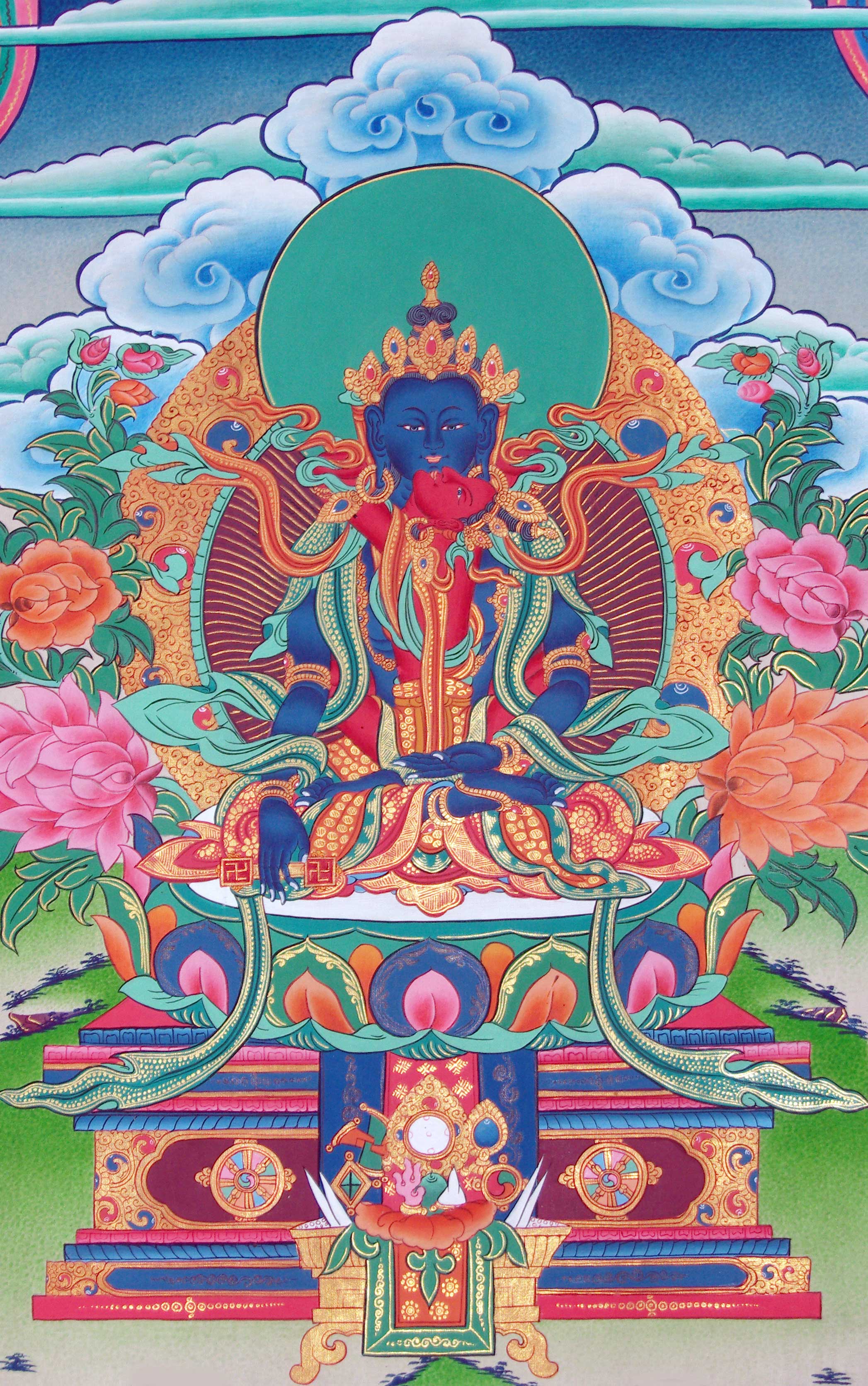
In order to show that beings of this world can also integrate their lives with practice, the Buddha showed conventional behaviour and married 360 incarnations of various worldly goddesses as well as Hoza Gyalmema (Tib. Hos-za Gyal-med-ma), an emanation of the female Buddha Jyamma (Tib. Yum-chen ‘Byams-ma), The Wisdom Goddess of Loving-Kindness.
6. Deed of Manifesting Progeny (Rnam-par sprul-pa’i mdzad-pa)
Although unconditioned by the affairs of this world, Tönpa Shenrab fathered eight sons and two daughters so that the royal lineage of Mushen (Tib. Dmu-gshen) would continue, thereby ensuring continuity of Yungdrung Bön as many of his children became important lineage holders and propagators of his Doctrine. Indeed, despite thousands of years and numerous obstacles, Shenrab Miwo’s blood line has survived to this day in Central Tibet, where the family is known as Gyalwa Shentsang (Tib. Rgyal-ba gshen-tshang).
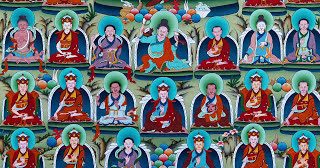
Tönpa Shenrab sons were:
Tobu Bumsang (Tib. Gto-bu ‘bum-sangs),
Chebu Trishe (Tib. Dpyad-bu khri-shes – lineage-holder of Bönpo medicine),
Lungden Salwa (Tib. Lung-ldan gsal-ba),
Gyudren Dronma (Tib. Brgyud-‘dren sgron-ma),
Kongtsa Wangden (Tib. Kong-tsha dbang-ldan),
Kongtsa Thrulbu (Tib. Kong-tsha ‘phrul-bu),
Woldrug Thangpo (Tib. ‘Ol-drug thang-po)
and Regent Mucho Demdrug (Tib. Gdung-sob Mu-cho ldem-drug).
It was Mucho Demdrug who took charge of the Yungdrung Bön doctrines and their propagation after the completion of the period of the Teachings of Body (Tib. sku-yi bstan-pa) when the period of the Teachings of Speech (Tib. gsungs-gi bstan-pa) began 10,000 years after Tönpa Shenrab’s birth. The third and final period of Tönpa Shenrab Miwo’s Yungdrung Bön, the Teachings of Mind (Tib. thugs-kyi bstan-pa) will begin in 3983. It will end in 13,983 when the new Buddha, Tönpa Thangma Medron (Tib. Ston-pa Thang-ma Me-sgron), will appear on this Earth and the next cycle of Yungdrung Bön will begin.
Tönpa Shenrab’s daughters were:
Shenza Nechen (Tib. Gshen-za ne-chen)
and Shenza Nechung (Tib. Gshen-za ne-chung).
7. The Deed of Subduing (Rnam-par ‘joms-pa’i mdzad-pa)
During this time, various demons tried to create many obstacles and problems for Tönpa Shenrab. The chief among the demons was Düd Khyabpa Lagring (Tib. Bdud Khyab-pa lag-ring), Pervasive Demon with Long Arms. The demons tried to deceive Tönpa Shenrab and his followers by resorting to various magical displays. They also tried to disturb them through direct attacks, but to no avail; Tönpa Shenrab transformed all negativities and adverse circumstances into virtue and beauty. However, Khyabpa Lagring did succeed in seducing Tönpa Shenrab’s younger daughter Shenza Nechung and, when her father was away in the realm of the Chya gods, he whisked her away to his realm of Radiant Darkness, Münpa Zerden (Tib. Mun-pa zer-ldan). Tönpa Shenrab went to the realm of the demons, rescued his daughter and also converted two of Khyabpa Lagring’s sons to Yungdrung Bön. This prompted Khyabpa Lagring to confess his misdeeds and the demon proffered five-folded offering to the Buddha. However, he was as yet not completely subdued.
Later, Khyabpa sent seven of his sons to steal seven horses of Shen and fetch them to Kongpo (Tib. Kong-po) in Tibet, where his demon father ruled. Although the Buddha was not attached to his property, he saw that this was a propitious time to tame demons and bring Yungdrung Bön to Tibet so he shot an arrow through the circular mountain range protecting Olmo Lungring and thus created the Arrow Way (Tib. mda’-lam), a tunnel to the Tibetan Plateau. He then travelled through this tunnel and went to Kongpo where he defeated the demons and destroyed their support-mountain. On the site of the demons’ mountain he emanated the Mountain of Bön known as Kongpo Bönri (Tib. Kong-po bon-ri).
The demons attacked Tönpa Shenrab but he again subdued them by summoning the armies of celestial warriors, the Drabla gods (Tib. sgra bla) of his ancestors, and by turning the demonic weapons into flowers. Khyabpa Lagring’s father, the demon Kongje Karpo (Tib. Kong-rje dkar-po), who ruled Kongpo at that time, together with his army of demons and the Tibetan people who worshiped the demons and supported them through rituals pertaining to certain streams of Prehistoric Bön (Tib. gdod-ma’i bon) confessed and returned the horses. Konje Karpo offered Tönpa Shenrab his daughter, Kongza Thricham (Tib. Kong-za khri-lcam), as a consort and all the demons as well as all the Tibetan people converted to Yungdrung Bön, becoming the Buddha’s followers and practitioners.
This made Khyabpa Lagring even angrier. Although he continued creating problems through magic, he was unable to harm the Buddha. Frustrated, he set fire to the treasury that housed the scriptures of Yungdrung Bön. The treasury was reduced to ashes but, thanks to Tönpa Shenrab’s wisdom and compassion, the Five Heroic Syllables (Tib. dpa’-bo ‘bru-lnga) appeared from the ashes. Three hundred and sixty-eight letters manifest from those Five Syllables, and so the teachings of Yungdrung Bön were restored and spread all over the world.
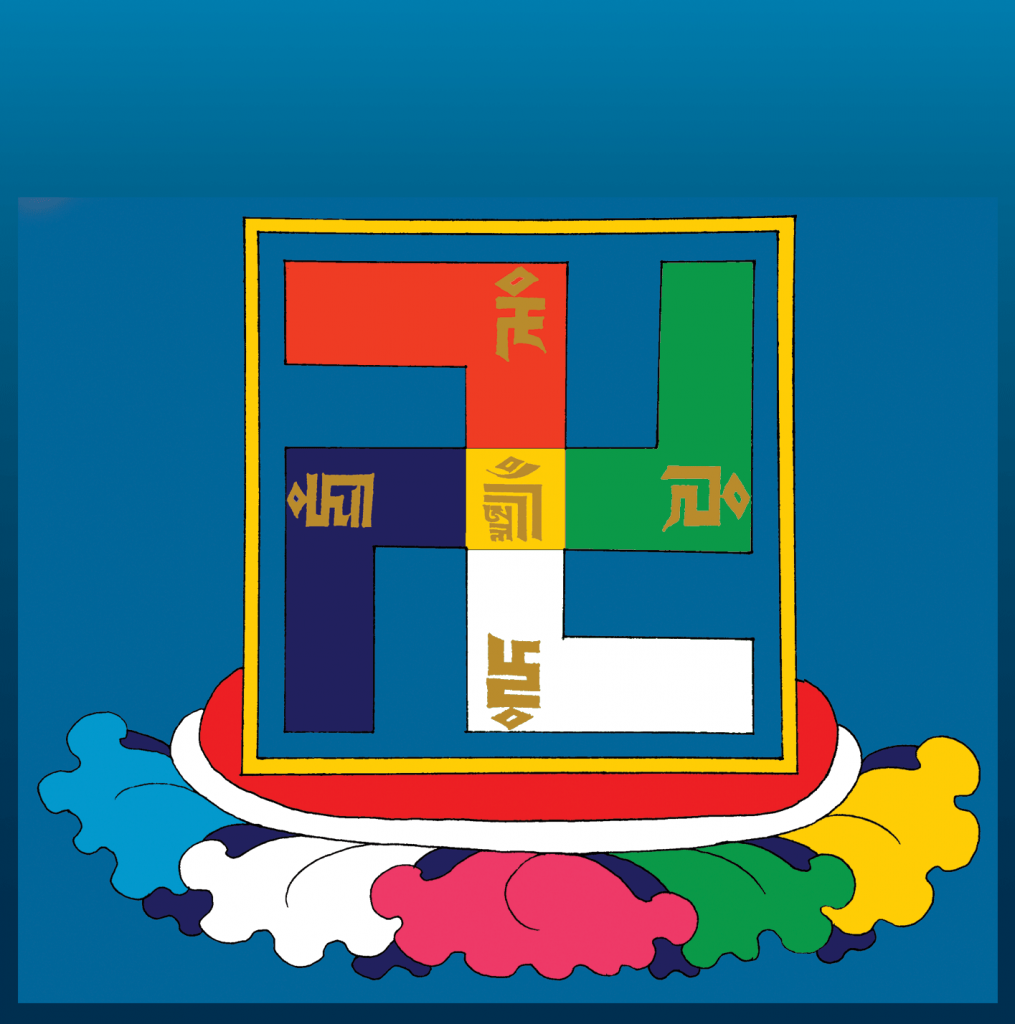
8. The Deed of Victory (Tib. Rnam-par rgyal-ba’i mdzad-pa)
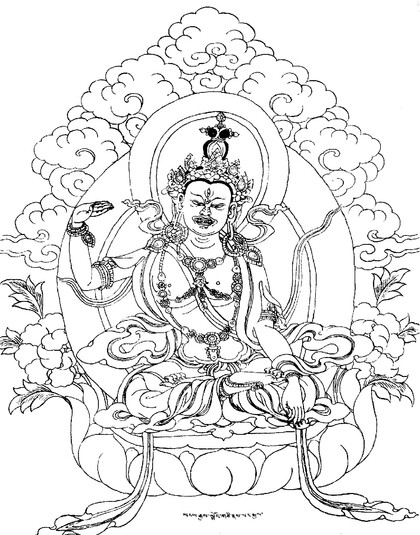
Among the Buddha’s disciples was the virtuous prince Gya Kongtse Thrulgyi Gyalpo (Tib. Gya Kong-rtse ‘Thrul-gyi rgyal-po), who was especially talented and very much devoted to Tönpa Shenrab and Yungdrung Bön. He wanted to build a great Bönpo temple (Tib. gsas-khang) in the middle of Lake Mukhyudal (Tib. Mu-khyud-dal). Thanks to previous positive karmic connections, Sinpo demons (Tib. srin-po) and Lu water-spirits (Tib. klu) agreed to help the prince work on the construction, but on one condition: no-one should know about the project and no-one should see them. Prince Kongtse agreed. He told no-one but his parents where he was going, and, ordering them not to reveal this to anyone, not even his wife, he departed. Time was passing and passing and Prince Kongtse’s wife grew desperate to know why her husband was not returning. She didn’t believe the stories her in-laws told her and kept asking and asking until they finally told her where her husband was. She set off at once. When she arrived at the shore of the lake, she saw the Sinpo and Lu working on laying the foundation for the great temple, which was rising just above the water. They caught sight of her at once and screamed at Kongtse, cursing him for breaking the promise. Furious, they wreaked havoc on the building site and then left. The prince was distraught. He was roaming around despairingly when he met Chase Kengtse (Tib. Chya-sras Keng-tse), the Deity of Wisdom. Chase Kengtse helped him to call back the demons and water-spirits and complete the construction. The temple was filled with symbolic supports: statues and thangkas representing the Buddha’s Body; scriptures symbolising his Speech; and chörten and tsa-tsa (Tib. mchod-rten, tsha-tsha) representing his Mind. But the demons rebelled once again and attempted to destroy the temple. Desperate now, Prince Kongtse invoked Tönpa Shenrab himself, and the Buddha arrived in an instant with a retinue of 5,500 Yungdrung Sempas (Tib. g.yung-drung sems-dpa’ – ‘spiritual heroes of swastika’, the bodhisattvas). Assuming the form of Nampar Gyalwa (Tib. Rnam-par rgyal-ba), The All-Victorious One, Tönpa Shenrab subdued the spirits. Then he consecrated the temple and taught the Bön of the Four Doors and Fifth, the Treasury (Tib. sgo-bzhi mdzod-lnga).
9. The Deed of Knowledge (Tib. Rnam-par rig-pa’i mdzad pa)
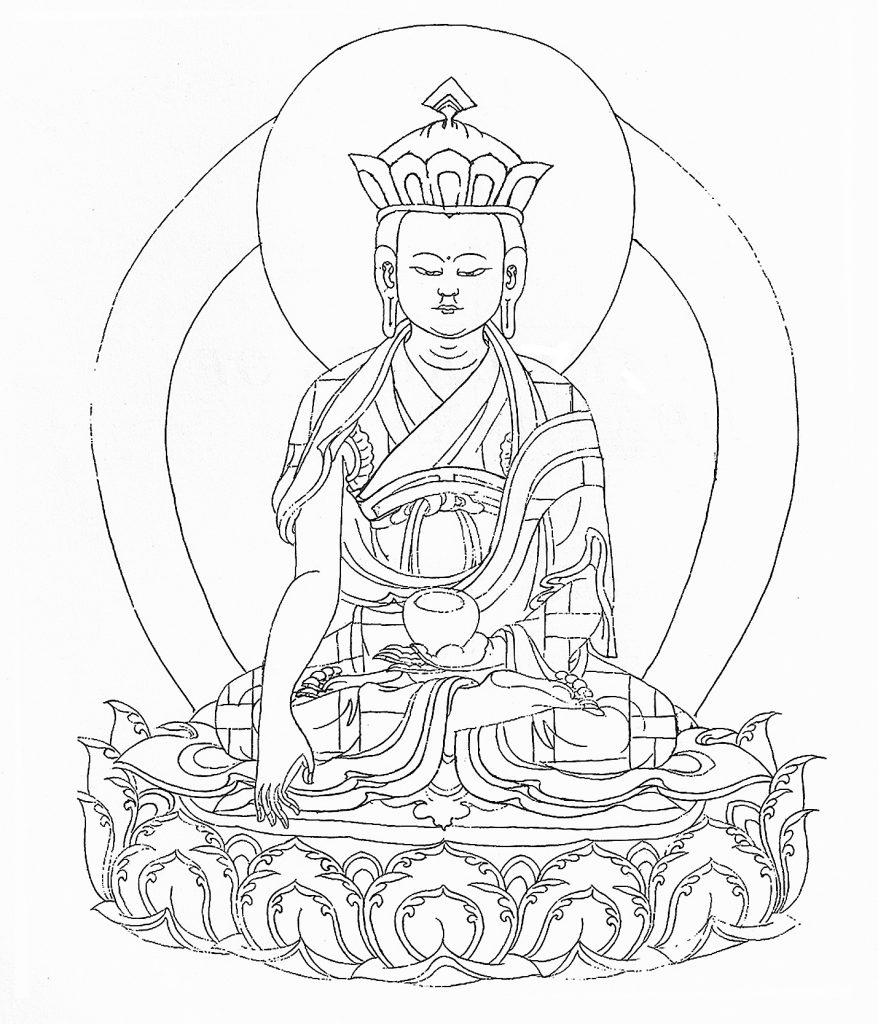
Although already a completely realised Buddha, in the thirty-first shen-year of his life Tönpa Shenrab decided to renounce the worldly life in order to show an example of renunciation. Thus he renounced his royal position and properties, and left the palace. Although some of his followers and retinue rejoiced and wanted to follow his example, others did not; they beseeched him to remain. But Shenrab Miwo was determined, and so he left. In the morning he recited the names of the 1000 Buddhas as well as the essential mantras, he took three white foods (Tib. dkar-gsum) and refrained from meat, wine and garlic. Then he put on monk’s robes, shaking his body he manifested wings and transforming to a half-human, half-bird shang-shang (Tib. shang-shang) he flew to the highest Pure Land (Tib. zhing-khams) of Ogmin (Tib. ‘Og-min). There, he received ordination from Drangsong Legden (Tib. Drang-srong legs-ldan). Then he descended to the Realm of the Thirty-three Gods (Tib. sum-bcu-rtsha-gsum lha-gnas) where he lived as an ascetic for a year and turned the Wheel of Bön for the Gods who dwelt there. After this, he descended to the Realm of the Four Great Kings (Tib. rGyal-chen ris-bzhi’i gnas) for another year and turned the Wheel of Bön there. Then he descended to this world. Practising austerity on the border of Olmo Lungring, he completely conquered Düd Khyabpa Lagring and his retinue of demons who became his followers and began practising Yungdrung Bön. After this, Buddha Tönpa Shenrab taught the Four Wheels of Bön (Tib. bon-‘khor tshig-bzhi). Afterwards, he bestowed various levels of lay and monk/nun ordination upon all of his followers and gave them teachings on pure conduct, vows and commitments.
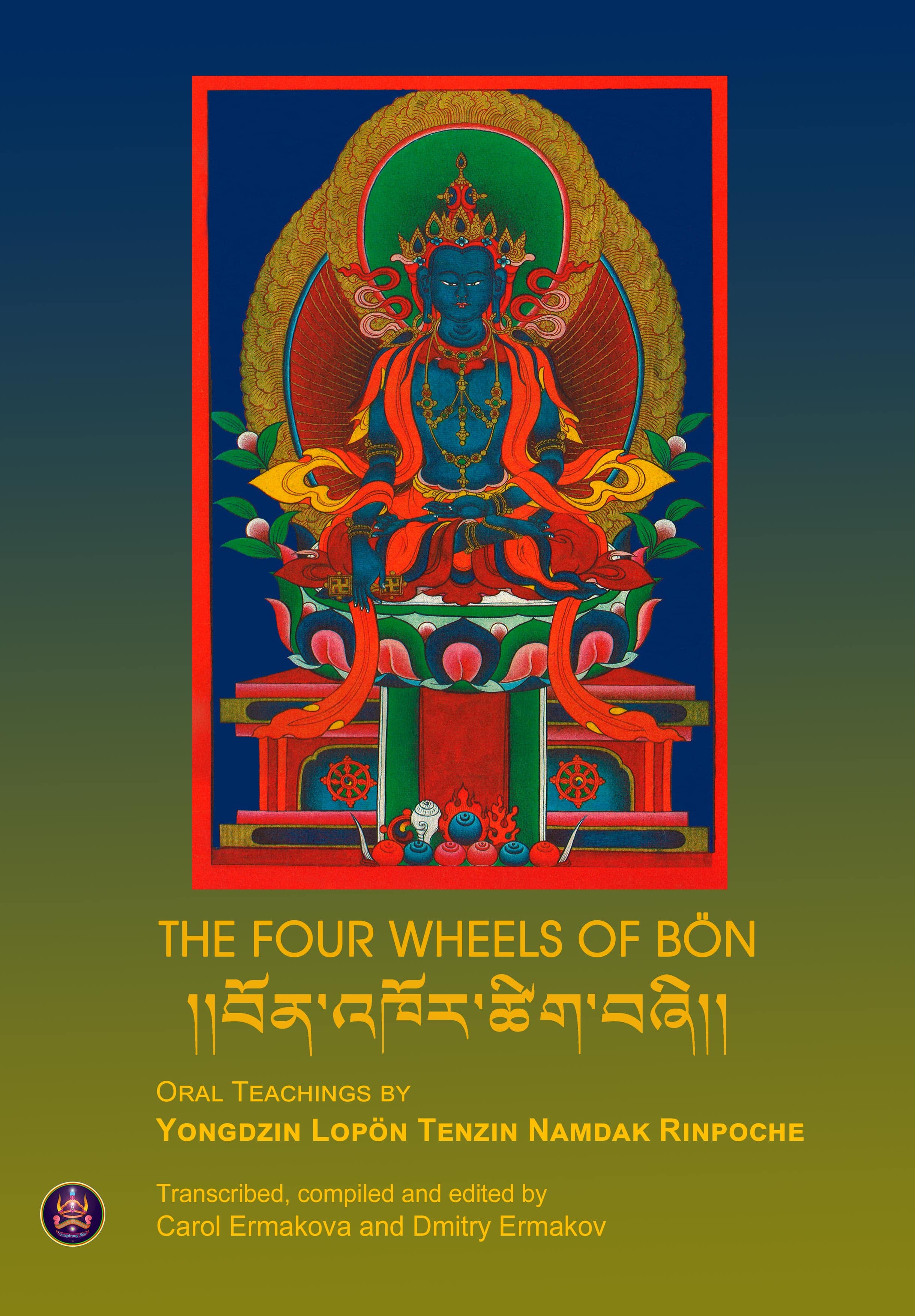
10. The Deed of Solitude (Tib. Rnam-par dben-pa’i mdzad-pa)
Tönpa Shenrab remained in solitude and silence in the forest at the Mount of Nine-Layered Swastikas (Tib. G.yung-drung dgu-brtsegs). Followers gradually gathered around him. To the disciples of higher capacity he taught Dzogchen while for those with lower capacity he gave provisional teachings on the gradual path (Tib. lam-rim).
11. The Deed of Liberation (Tib. Rnam-par grol-ba’i mdzad-pa)
Then Tönpa Shenrab gave the teachings on how to realise the view by looking from the highest to the lowest levels of the teachings, and on how to practise virtuous conduct by taking great compassion as the base and climbing up the stages (Tib. sa) by the means of the Ten Perfections (Tib. pha-rol-tu phyin-pa bcu). He also gave prophesies for the future of Yungdrung Bön as well as various other discourses.
12. The Deed of Realization (Tib. Rnam-par grub-pa’i mdzad-pa)
In order to demonstrate the transient nature of cyclical existence (Tib. ‘khor-ba), while staying at the Mount of Nine-Layered Swastikas, Yungdrung Gutseg, Tönpa Shenrab manifested sickness and became ill. Extremely worried, his followers and disciples begged him to move into the Trimon Gyalzhe palace (Tib. Khri-smon rgyal-bzhed). There, Tönpa Shenrab’s son, Tobu Bumsang, performed To rituals (Tib. gto) while his other son, Chebu Trishe, performed diagnostics and medical treatment. And so, in order to demonstrate the validity of relative truth (Tib. kun-rdzob bden-pa), Tönpa Shenrab recovered from the illness. After some time, however, he caused the illness to reappear. Although his followers beseeched him not to depart, he began giving the teaching on the liberation at the time of death. Then, in the eighty-second shen-year of his life, displaying countless miraculous and auspicious signs, Tönpa Shenrab went into parinirvana (Tib. mya-ngan las-‘das-pa) on the thirtieth day of the first Winter month of the Water Hare Year (i.e. 7817 BC). His body was cremated and the Eighteen-fold offering ritual (Tib. Cho-ga ‘phrin-las bco-brgyad) was performed, after which the holy relics were divided between the humans, the Hla-gods (Tib. lha) and the Lu water-gods as supports for their refuge.
Bibliography:
Berzin, Alexander. “An Introduction to Tibetan Astronomy and Astrology.” The Tibet Journal, vol. 12, no. 1, 1987, pp. 17–28. JSTOR, www.jstor.org/stable/43300228. Accessed 26 Jan. 2021.
Ermakov, Dmitry. Bѳ and Bön: Ancient Shamanic Traditions of Siberia and Tibet in their Relation to the Teachings of a Central Asian Buddha, (Kathmandu: Vajra Publications, 2008).
Kvaerne, Per. The Bon Religion of Tibet, (London: Serindia Publications, 1995).
Namdak, Yongdzin Lopön Tenzin. The Nine Ways of Bön; A Compilation of teachings in France, Volume I, 9 September – 9 December 2006, Trnscr. & ed. Carol Ermakova and Dmitry Ermakov (Blou: Shenten Dargye Ling, 2006).
____________. Trnscr., Comp. & Ed. Carol Ermakova & Dmitry Ermakov. The Four Wheels of Bön ༎བོན་འཁོར་ཚིག་བཞི།།, Oral Teachings by Yongdzin Lopön Tenzin Namdak Rinpoche, (UK: FPYB, 2016).
Norbu, Namkhai. Drung, Deu and Bön: Narrations, Symbolic language, and the Bön tradition in ancient Tibet, (Dharmasala: LTWA, 1995).
Sangye, Menri Lopon Tenzin. Tr. Sangye Tandar, Ed. Richard Guard. The Twelve Deeds: A Brief Life Story of Tonpa Shenrab , the founder of Bon religion, (Dharmasala: LTWA, 2003 reprint).
Snellgrove, David. The Nine Ways of Bön, (London: Oxford University Press, 1967).
Endnotes:
[1] Berzin, Alexander. “An Introduction to Tibetan Astronomy and Astrology.” The Tibet Journal, vol. 12, no. 1, 1987, pp. 17–28. JSTOR, www.jstor.org/stable/43300228. Accessed 26 Jan. 2021.
[2] See Norbu, Drung, Deu and Bön, pp. 156–158.
[3] I.e. Yongdzin Lopön Tenzin Namdak, Khenpo Tenpa Yungdrung, Geshe Gelek Jinpa. Drubdra Khenpo Tsultrim Tenzin keeps an open mind regarding this dating.
[4] See Ermakov, Dmitry. Bѳ and Bön: Ancient Shamanic Traditions of Siberia and Tibet in their Relation to the Teachings of a Central Asian Buddha, (Kathmandu: Vajra Publications, 2008), Spread of Bön in Eurasia, pp. 704-705.
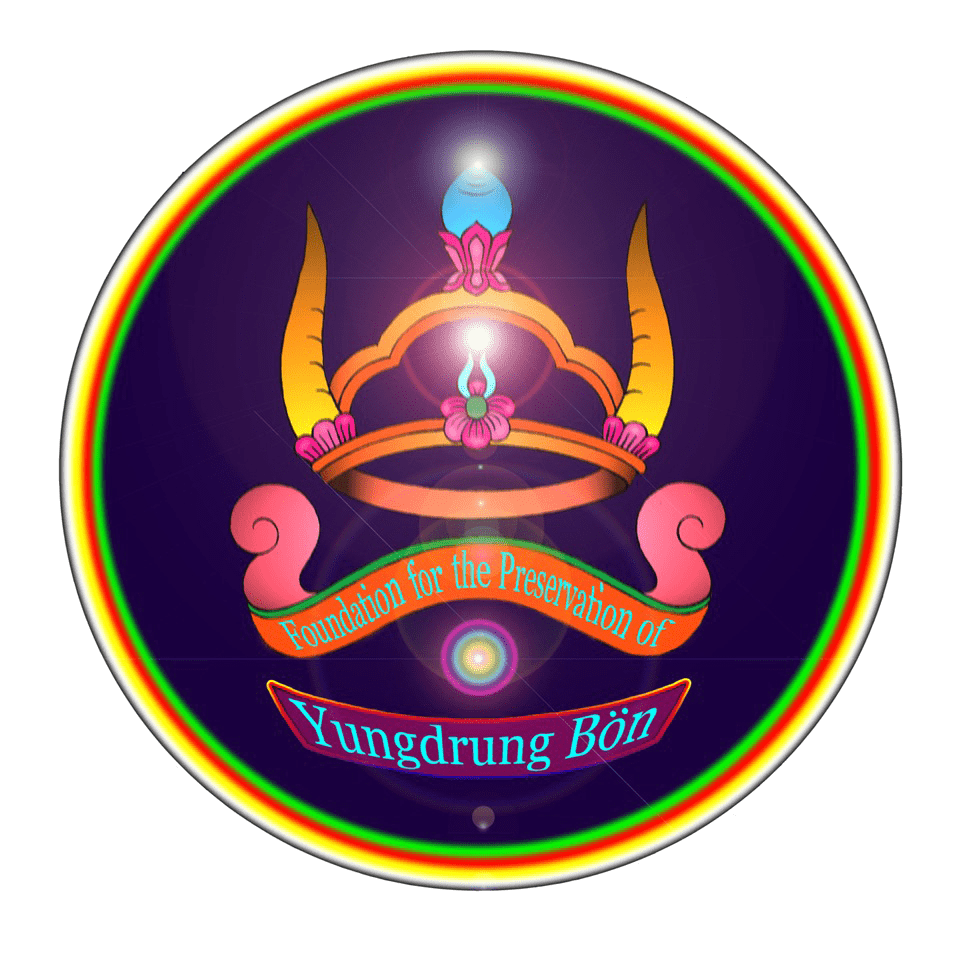
11 Responses
[…] One way we seek to preserve the teachings and traditions of Yungdrung Bön is by marking significant anniversaries of great teachers. As well as commemorating these dates with practice, FPYB also provides brief articles detailing their life stories. You can read some here: https://yungdrungbon.co.uk/2021/03/06/three-drenpa-namkhas-in-yungdrung-bon/, https://yungdrungbon.co.uk/2021/01/28/anniversary-of-tonpa-shenrab-miwos-birth-a-brief-introduction-…. […]
True Old Spiritual Bon
[…] Anniversary of Buddha Tönpa Shenrab Miwoche (Tib. Rgyal-ba Ston-pa Gshen-rab Mi-bo-che) completing the Twelfth Deed, The Deed of Realisation (Tib. rnam-par grub-pa’i mdzad-pa), when he achieved nyangen ledepa (Tib. mya-ngan […]
[…] Read the full article […]
Tom Wilen Professor from New York born in Finland ; ten years of research going back to 20,000 years ago Ultima Thule island above the Arctic Circle where Aryans and Sanskrit originated and where high protein food enabled liturgical reciting orally of what would be Kalevala and Rig Vedas. Migration to Lithuania where Sanskrit spoken today then Ukraine Caucasus Iran and 18,000 to Tibet Mt Kailash as you are living ancestors of.
Thanks. Yes, more or less like this. There is detailed exploration of this possible route in Ermakov, Dmitry. Bө and Bön: Ancient Shamanic Traditions of Siberia and Tibet in their relation to the Teachings of a Central Asian Buddha, (Kathmandu: Vajra Publications, 2008), Ch. XV @ https://www.amazon.co.uk/Bo-Bon-Shamanic-Traditions-Teachings/dp/9937506115
[…] Read full article “Anniversary of Tönpa Shenrab Miwo’s Birth – a brief introduction t… […]
[…] Anniversary of Buddha Tönpa Shenrab Miwoche (Tib. Rgyal-ba Ston-pa Gshen-rab Mi-bo-che) completing the Twelfth Deed, The Deed of Realisation (Tib. rnam-par grub-pa’i mdzad-pa), when he achieved nyangen ledepa (Tib. mya-ngan […]
[…] Translated by Dmitry Ermakov for Khenzur Nyima Wangyal Rinpoche, “Journey to Meditation”, 2019. Read full article “Anniversary of Tönpa Shenrab Miwo’s Birth – a brief introduction t… […]
[…] Twelve Deeds of Tönpa Shenrab Miwoche […]
[…] READ ARTICLE […]